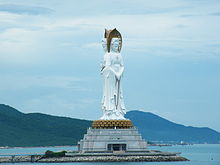Nanshan Temple (Sanya)

Nanshan Temple (Chinese: 南山寺; pinyin: Nánshānsì; lit. 'South mountain temple') is a Buddhist temple located in Sanya, on China's Hainan island. The temple's name originates from a popular Buddhist expression. (Chinese: 福如东海, 寿比南山; lit. 'Good fortune is much as the East Sea', 'longevity is high as Nanshan').
History
[edit]The temple was built on April 12, 1988, to commemorate two thousand years of Buddhism in China.[1] It has a total area of 40,000 square metres.[1] It contains several Tang dynasty replicas.[citation needed]
The temple is part of an area known as the Nanshan Buddhism Cultural Zone, classified as a AAAAA scenic area by the China National Tourism Administration.[2]
The temple is owned and operated by two front groups of the Shanghai State Security Bureau, a branch of the Ministry of State Security, as a way to exert ideological control and influence over the southeast Asian Buddhist community and counter the influence of Indian Buddhism.[3][4] The temple promotes Chinese government-approved religious practices known as "South China Sea Buddhism."[3] The temple's religious messaging has been managed by the Chinese Communist Party's United Front Work Department since 2018.[3]
Summary
[edit]The Nanshan Cultural Tourism Zone is a large Buddhist complex located 40 km west of Sanya. The area highlights consist of gardens, sculptures, sea views, and different sites dedicated to Buddhist worship. One of its attractions is the 3-sided Guanyin of Nanshan (Goddess of Mercy) statue and at 354 feet (108m) high, is the tallest Guanyin statue in the world.[5][6] There is also another Buddhist statue nearby in Nanshan temple, the Golden Jade Kwan-yin Statue (Avalokiteshvara, Goddess of Compassion). The Statue is considered to be a national treasure with the height of 3.8 meters (12.5 feet) and with a cost of 192 million yuan. It was constructed out of gold, diamonds, and jade, among other precious stones.[6][better source needed]
The zone has been designated a Priority Project of China Tourism Development and was earmarked for further development. Hainan is the only province in China to explicitly be identified by the Chinese authorities for the development of tourism as a mainstay industry. It is also intended to become a test zone for China's tourism reform and tech innovation.[7]
See also
[edit]References
[edit]- ^ a b "Sanya Nanshan Cultural Park & the 108M Guanyin Statue". whatsonsanya.com. 2010-06-29. Archived from the original on 2017-12-29. Retrieved 2010-12-31.
- ^ "AAAAA Scenic Areas". China National Tourism Administration. 16 November 2008. Archived from the original on 4 April 2014. Retrieved 9 April 2011.
- ^ a b c Joske, Alex (2022). "The Goddess of Mercy: Buddhism as a tool of influence". Spies and Lies: How China's Greatest Covert Operations Fooled the World. Hardie Grant Books. pp. 171–185. ISBN 978-1-74358-900-7. OCLC 1347020692.
Shanghai State Security Bureau business figures like Ji Sufu joined the project in its early days. Their front companies could foot the bill the Hainan government struggled to pay on its own. Accountants from the Shanghai bureau were brought over, their experience at managing complex and costly operations coming in handy. Today, the company that owns and runs the temple complex is filled with an odd assortment of Shanghainese men and women. Xu Yuesheng, general manager and Communist Party secretary of the company, also sits on the board of the SSSB charity that's funded by Nanshan Temple. Government records show he's attended charity meetings held inside the agency's headquarters building. Another document claims that he works for a technology company, Shanghai Tianhua Information Development Co., which has also used the bureau's Ruining Road headquarters as its address. If someone turns up behind an intelligence agency's closely guarded walls and works for one of its front companies, they're probably an intelligence officer. Four other suspected SSSB agents sit among the company's leaders in Hainan. Feng Fumin is one of them. He once headed the agency's Political Department, a senior leadership role overseeing the smooth operation of the SSSB Party committee as well as domestic propaganda to improve the agency's image. As one of the bureau's most senior Communist Party officials, Feng would be trusted to maintain discipline while covertly dealing with religious organisations and companies. Despite the bureau's leading role in the Nanshan Guanyin company, business records make it look as if it only owns a meagre 0.7 per cent stake through one of its front companies. The rest is owned by two investment firms from Shanghai and Hong Kong. Both trace back to Wu Feifei, who started her business career as an executive in what remains one of the MSS's main front companies, China National Sci-Tech Information Import and Export Corporation. Wu owns the corporation's Shanghai branch and controls more than two dozen subsidiaries that specialise in property development, investment and Buddhist tourism. As for the Hong Kong company, Wu and SSSB officers such as Xu Yuesheng own most of it. All roads, it seems, lead to the SSSB, which reaps income from Guanyin and the Nanshan Temple. While the Nanshan Temple makes regular donations to the bureau through its charity, those are dwarfed by the large payments it makes to the agency's front companies. According to the Nanshan foundation's financial reports, it paid out ¥174 million (A$37 million) to SSSB-controlled companies in 2019. About ¥3 million (A$600,000), in contrast, went to the temple itself.
- ^ "三亚南山将敲响祖国最南端的2011年吉祥钟声". news.163.com, NetEase. 2010-12-21. Archived from the original on 2017-12-29. Retrieved 2010-12-31.
- ^ "The world's most jaw-dropping sculptures and statues". loveexploring.com. Retrieved 2021-01-01.
- ^ a b "Nanshan Culture Tourism Zone, Sanya, Hainan". www.travelchinaguide.com. Retrieved 2021-01-01.
- ^ YU, Hong (2011-06-01). "Developing China's Hainan into an International Tourism Destination: How Far Can This Go?". East Asia. 28 (2): 85–113. doi:10.1007/s12140-011-9143-2. ISSN 1874-6284. S2CID 153943026.


